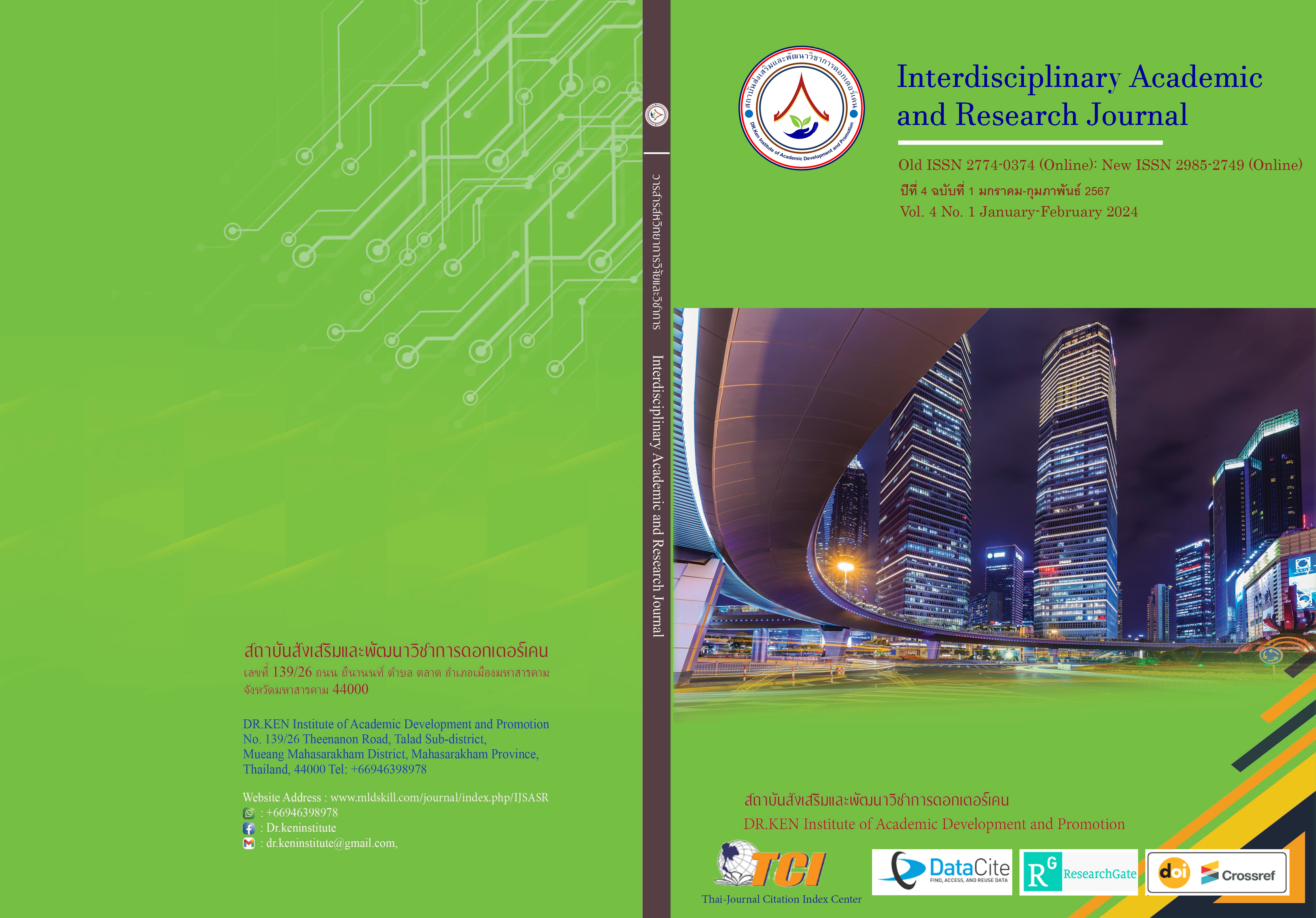Development of Instruction Model with Participatory Learning to Enhance Educational Innovator for Pre-Service Teachers
DOI:
https://doi.org/10.60027/iarj.2024.274101Keywords:
Instructional Model; , Participatory Learning; , Educational InnovatorAbstract
Background and Aims: The design of teaching and learning activities must have guidelines or formats to serve as models for organizing activities or guidelines for learners to interact together. The objectives of the research are 1) to create an instruction model with participatory learning to enhance educational innovator for Pre-Service teachers, 2) to study the results of using an Instruction model with participatory learning to enhance educational innovator for Pre-Service teachers.
Methodology: The tools used in the research include: 1) instruction model with participatory learning to enhance educational innovator for Pre-Service teachers, 2) evaluation of educational innovator. The sample group consisted of 30 Pre-Service teachers enrolled in the subject Innovation and Information Technology for Education, obtained by simple random sampling by lottery. Statistics used in data analysis include mean, percentage, standard deviation, and T-test.
Results: 1) Instruction model with participatory learning to enhance educational innovator for Pre-Service teachers consists of 1) elements of the model as follows: 1.1) concepts or theories 1.2) objectives of the model 1.3) methods Organize teaching and learning committee activities 1.4) Measurement and evaluation 2) The learning and teaching process includes step 1 analysis, step 2 reflection, step 3 planning, step 4 evaluation, 3) results are the characteristics of the Educational innovation consists of 3.1) ability, 3.2) behavior, 3.3) attitude. Instruction model quality Evaluated by 3 experts, the quality was at a very good level with an average of 4.43 or 88.57 percent. 2) Pre-service teachers' scores as innovators after studying were significantly higher than their pre-study scores at the .05 level.
Conclusion: the participatory teaching and learning model designed to foster educational innovation among teacher-students encompasses key components and processes, yielding highly-rated educational innovators. Expert assessments highlight the model's exceptional quality, with an 88.57% satisfaction level. Furthermore, statistically significant improvements in students' educational innovation scores post-engagement underscore the model's effectiveness.
References
กรมสุขภาพจิต กระทรวงสาธารณสุข. (2544).รายงานการวิจัย เรื่อง การสร้างแบบประเมินทักษะชีวิตและผลการส่งเสริมทักษะชีวิตโดยใช้โรงเรียนเป็นฐาน
กิดานันท์ มลิทอง. (2548). เทคโนโลยีและการสื่อสารเพื่อการศึกษา. กรุงเทพฯ : อรุณการพิมพ์.
ทิศนา แขมมณี. (2551). รูปแบบการเรียนการสอน : ทางเลือกที่หากหลาย. พิมพ์ครั้งที่ 5. กรุงเทพฯ : สำนักพิมพ์จุฬาลงกรณ์มหาวิทยาลัย.
ธร สุนทรายุทธ. (2551). การบริหารจัดการเชิงปฏิรูป : ทฤษฎี วิจัย และปฏิบัติทางการศึกษา. กรุงเทพฯ : บริษัท เนติกุลการพิมพ์ จำกัด .
บุญชม ศรีสะอาด. (2553). การวิจัยเบื้องต้น. พิมพ์ครั้งที่ 8. กรุงเทพฯ : สุวีริยาสาส์น.
ปิยนันต์ คล้ายจนัทร์ และ ประทุมทอง ไตรรัตน์. (2564). รูปแบบการเสริมสร้างความเป็นนวัตกรสําหรับหลักสูตรระดับปริญญาตรี ของมหาวิทยาลัยเอกชนในประเทศไทย. วารสารสังคมศาสตร์และมานุษยวิทยาเชิงพุทธ, 6(8), 236-252.
พรทิพย์ ศิริสมบูรณ์เวช. (2547). การพัฒนารูปแบบการเรียนการสอนวรรณคดีไทย ตามทฤษฎี การตอบสนองของผู้อ่าน เพื่อเสริมสร้างความสามารถด้านการตอบสนองต่อวรรณคดี การอ่านเพื่อความเข้าใจ และการคิดไตร่ตรองของนิสิตระดับปริญญาบัณฑิต. วิทยานิพนธ์ครุศาสตรมหาบัณฑิต บัณฑิตวิทยาลัย จุฬาลงกรณ์มหาวิทยาลัย.
ภัทร์สุดา คมขำ. 2563. โครงการบริหารธุรกิจมหาบัณฑิตสำหรับผู้จัดการยุคใหม่. การค้นคว้าอิสระสาขาวิชาการบัญชี คณะบริหารธุรกิจ มหาวิทยาลัยรามคำแหง
วสันต์ สุทธาวาศ และ พิทักษ์ ศิริวงศ์. (2558). วิธีพัฒนาศักยภาพความเป็นนวัตกรการศึกษา. วารสารวิขาการ Veridian E-Journal, Silpakorn University. 8 (2), 281-300.
วสันต์ สุทธาวาศ. (2559). การพัฒนาโปรแกรมเสริมสร้างศักยภาพความเป็นนวัตกรการศึกษา. วิทยานิพนธ์หลักสูตรปริญญาปรัชญาดุษฎีบัณฑิต สาขาวิชาการจัดการ บัณฑิตวิทยาลัย มหาวิทยาลัยศิลปากร
สาธารณสุข, กระทรวง.กรมสุขภาพจิต. (2544). คู่มือฝึกอบรมแบบมีส่วนร่วม. พิมพ์ครั้งที่ 4. กรุงเทพฯ : วงศ์กมล โปรดักชั่น จำกัด.
สุมณฑา พรหมบุญ. 2540. ทฤษฎีการเรียนรู้แบบมีส่วนร่วม. กรุงเทพฯ: สำนักงาน คณะกรรมการการศึกษาแห่งชาติ.
เสาวนีย์ เดือนเด่น และคณะ. (2558). การมีส่วนร่วมในการทำงานของบุคลากร. กรุงเทพฯ: มหาวิทยาลัยรามคำแหง
อรุณี สถิตภาคีกุล. (2542). การจัดการเรียนการสอนที่เน้นผู้เรียนเป็นศูนย์กลาง. โครงการตำราวิชาการราชภัฏเฉลิมพนะเกียรติ เนื่องในวโรกาสพระบาทสมเด็จพระเจ้าอยู่หัวทรงเจริญพระชนพรรษา 6 รอบ. คณะครุศาสตร์ สถาบันราชภัฏนครศรีธรรมราช.
โอภาศ วุฒิเศลา, ชวนคิด มะเสนะ, วิสุทธิ์ราตรี (2560). การจัดการแบบมีส่วนร่วมในการจัดการเรียนรู้ตามหลักปรัชญาของเศรษฐกิจพอเพียงของสถานศึกษาขั้นพื้นฐาน. วารสารวิจัยรำไพพรรณี, 11(2) ,110-119.
Cohen, J.M., & Uphoff, N.T. (1980). Participation’s Place in Rural Development: Seeking Clarity Throung. World Development.
Dyer, J.H., Gregersen, H.B., & Christensen, C.M. (2011). The Innovator's DNA: Mastering the Five Skills of Disruptive Innovators. Boston, MA: Harvard Business Press,
Eggen, P.D., & Kauchak, D.P. (2000). Educational Psychology Windows on classrooms. 5th edition. New York: Prentice Hall.
Joyce, B., Weil, M., & Showers, B. (1992). Model of teaching. 4th edition. Boston: Allyn and Bacon: A Divison of Simon & Schuster, Inc.
Kolb, D. A. (1984). Experiential Learning: Experience as the Source of Learning and Development. Englewood Cliffs, NJ: Prentice Hall.
Rogers, E.M. (1983). Diffusion of innovations. 3rd edition. The Free Press, A Division of Macmillan Publishing Co., Inc.
Saylor, J.G., Alexander, W.M., & Lewis, A.J. (1981). Curriculum Planning for Better Teaching and Learning. Holt, Rinehart and Winston, New York.
Downloads
Published
How to Cite
Issue
Section
License
Copyright (c) 2024 Kittiya Plodkaew

This work is licensed under a Creative Commons Attribution-NonCommercial-NoDerivatives 4.0 International License.
Copyright on any article in the Interdisciplinary Academic and Research Journal is retained by the author(s) under the under the Creative Commons Attribution-NonCommercial-NoDerivatives 4.0 International License. Permission to use text, content, images, etc. of publication. Any user to read, download, copy, distribute, print, search, or link to the full texts of articles, crawl them for indexing, pass them as data to software, or use them for any other lawful purpose. But do not use it for commercial use or with the intent to benefit any business.
















.png)


